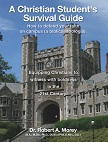HERMENEUTICS
By Dr. Robert A. Morey
Introduction
The importance of rightly interpreting Scripture cannot be underestimated. If the people of
God do not know how to read the Bible, false teaching will easily deceive them.
I. What is Hermeneutics?
Hermeneutics is the discovery, understanding and use of those linguistic and literary principles and rules of interpretation which should be followed when interpreting the Bible. Exegesis is the application of hermeneutics to a particular text of Scripture to discern the intent and mind of the author. It is the opposite of eisegesis which is the reading into a text your own ideas with little or no concern for what the author was saying.
Exegesis—Superstructure (application) Hermeneutics—Foundation (principles)
II. Why Bother with Hermeneutics?
A. The Bible comes to us as literature: (prose, poetry, historical narrative, apocalyptic literature, letters, dialogue, theological treatise, biography, etc.)
B. Hermeneutics is simply the mind’s reflection on the valid ways people read and interpret any piece of literature.
1. We must observe grammar and syntax.
2. We must observe literary units such as paragraphs and chapters.
3. We must seek to discern what the author was saying.
C. There are right ways and wrong ways to interpret the Bible.
1. The right way: 2 Tim. 2:15, cf. Matt. 22:29–32
2. The wrong way: 2 Pet. 3:16
a. Partial quotation: “There is no God” (Psa. 14:1).
b. Not observing who said it: “You shall be as God” (Gen. 3:5).
c. Bringing together unrelated proof texts.
d. Taking a verse out of context: example Col. 2:21.
e. A mystical approach, where you let the Bible fall open at random and pick a verse by “chance.”
D. This means that it is erroneous to say, “The Bible can be validly interpreted in many different ways.” Except for a few difficult places, the Bible will have only one valid interpretation if the principles of hermeneutics are consistently followed. We should interpret the Bible following objective rules. The reason we are not consistent in this is that we often allow religious and personal prejudices and a denominational bias to influence our interpretation. We approach the Bible to make it say what we want instead of letting it speak for itself. Hermeneutics is an attempt to curb inconsistent and biased interpretation.
III. Where Should We Obtain Our Hermeneutical Principles?
A. The foundational principle of approach: The same basic linguistic and literary rules which we use when interpreting any historic or contemporary literature should be used when reading the Bible. Since the Bible does not contain any unique literary forms, our hermeneutics should not be unique only to Scripture.
B. This principle reveals the basic error of liberal and neo-orthodox hermeneutics. They have developed hermeneutical principles which cannot be applied to any historic or contemporary literature, but which they applied to the Bible to discredit it.
1. The J.E.P. D. Higher Critical Theory cannot be applied to Homer, Plato, Shakespeare or contemporary works.
2. A computer analysis of vocabulary cannot be applied to literature in general. C. This basic principle also reveals the error of Medieval or Roman Catholic
hermeneutics. It was taught that a text had three meanings:1. A literal meaning which ignorant and uneducated people could discern.
2. A moral meaning which educated and cultured people could discern.
3. A spiritual meaning which only the clergy could discern.
D. This basic principle also reveals the fallacy of cultic and occultic hermeneutics. Each cultic or occultic leader or group gives an “inner” or “secret” meaning which is not discernible from the text. Their interpretation ignores grammar, syntax, context, etc.
Examples: Christian Science
The Church of Bible Understanding
The Watchtower
The Metaphysical Bible Dictionary
E. The fact that the Bible was written in everyday language for normal people dispels all “secret” and “mystical” interpretations. A “plain” Bible written for “plain” people needs a “plain” interpretation. There are no “secret keys” to interpreting the Bible because it does not come to us as a locked book waiting for some special mystical interpreter to arrive on the scene.
IV. How Should We Approach the Bible?
A. In an Attitude of Worship: Isaiah 66:1–2; Psa. 119:97; Psa. 138:2; John 1:1–2
1. Spirit of dependence: Psa. 119:18, 24; 1 Cor. 2:11–12; Lk. 24:25–3
2. Spirit of submission: John 7:17; Psa. 119:4, 5, 11; Heb. 11:6.
B. It involves our Whole Being:
1. Mind—Call to believe: Jn. 20:31; Acts 17:10–12.
2. Will—Call to obey: Rev. 2:5; Psa. 119:33–35; Matt. 7:24.
3. Emotions—Call to feel: Phil. 3:1; Jn. 15:11–12.
V. Who Should Interpret the Bible?
The Basic Qualifications of the Interpreters of Scripture:
A. We must have a heart regenerated by the Holy Spirit (John 3:3–5). Why? Because the natural man cannot understand the things of God (1 Cor. 2:11–12; Rom. 3:11).
1. The sinful nature of man renders him incapable of understanding the truth (Rom. 8:
3–9).
2. Man’s love of darkness renders him unwilling to understand the truth (John 3:19–21; John 5:40).
3. Man’s allegiance to Satan and to sin renders him rebellious against understanding the truth (John 8:43–47).
B. We need a mind illuminated by the Holy Spirit.
Example: Paul’s prayers on behalf of the saints (Eph. 1:17)
C. We must have an impartial and seeking spirit. We must come to the Bible totally convinced that we want nothing but the truth. Some use the Bible to prove their pet ideas or to defend their denominational doctrines. We should come realizing that the truth
1. liberates (John 8:32)
D. We must have a humble spirit. Why?
2. sanctifies (John 17:17)
The Spirit renders man capable of worshiping the true God (John 4:23–24).1. God resists the proud (James 4:6).
2. God reveals to the humble (Matt. 11:25).
3. Man knows so little (1 Cor. 8:2; 13:9–12).
E. We must have a praying heart (Psa. 119:18, 34, 73, 125, 144 and 169).
F. We must have a pious motive (Psa. 119:34, 73; Col. 1:9–12).
VI. Basic Principles of Interpretation
A. The Absolute Inspiration of the Scriptures, The Orthodox position: the verbal, plenary, inspiration of the infallible, inerrant Bible which is the Word of God.
1. Verbal: Every single letter and word of Scripture as put down in the original autographs were inspired of God (Matt. 5:18; 22:32).
2. Plenary: All of the Bible, in all of its parts, is equally inspired. No part is more inspired than the other parts. The 66 books comprising the Old and New Testaments are all equally inspired (Matt. 5:17–18; 2 Tim. 3:16).
3. Inspiration: God sovereignly prepared the authors of Scripture from birth in all things. He stirred them up to write. He guided them so they wrote down everything He wanted them to write. They wrote down the very words of God. Gods sovereign control of the authors did not remove the characteristics and personalities of the authors, but such things were ordered by God to be a better vehicle of expression.
4. Infallible: In principle, the Bible is infallible, i.e., incapable of error or mistake.
Why? God cannot lie (Titus 1:2), and the Bible is His Word; therefore, the Bible cannot be a lie (John 17:17).
5. Inerrant: This is biblical infallibility stressed in the area where it touches on matters of science and on any observations and explanations of the natural world. Example: Creation” the Flood, miracles, history, etc. The Bible is scientifically correct wherever it speaks in those areas.
6. Bible: The books in the Protestant Bible. There are no “lost” books. The
Apocrypha is not inspired.
7. Word of God: The Word of God expressed in human words. It is human and "Divine” with the Divine so controlling the human element, that nothing is expressed but the thoughts and Will of God.
B. The Unity of the Bible
Although it was written by more than 40 different authors from many different walks of life over a period of 2,000 years, with no collaboration between authors, the Bible is a harmonious unit. It contains no contradictions. The New Testament does not contradict the Old Testament. Paul does not contradict Jesus or James. All the teachings of the Bible dovetail into each other. The Bible presents one, consistent, cohesive, coherent view of truth throughout all its parts. Liberals say that the Old Testament and the New Testament contradict each other and even present different gods. This comes from ignorance, both spiritual and scriptural. The following chart reveals how the New Testament completes the Old Testament.
Old Testament |
New Testament |
Unexplained Ceremonies |
Ceremonies Explained |
Unfulfilled Prophecies |
Prophecies Fulfilled |
Unsatisfied longings |
Longings Satisfied |
Incomplete Destiny |
Destiny Completed |
Some liberal theologians have claimed that Jesus contradicted the Old Testament in His Sermon on the Mount. Look at Matthew 5 where they say Christ contradicts the Old Testament and throws out the “eye for eye and tooth for tooth” doctrine of the primitive and uncivilized Jews who believed in a bloody and savage tribal war-god named Jehovah. In its place, Jesus teaches the Fatherhood of God, the brotherhood of man, pacifism and other teachings shared by all the great religious leaders of all religions.
The Liberal misinterprets Matthew 5 completely, for
1. Christ came to fulfill, not to contradict or destroy (Matt. 5:17–19).
2. Christ was contradicting the Pharisees’ interpretation of the Law which had externalized it.
a. He did not say “As it is written.”
b. He did not quote Scriptures but the Rabbis (Matt. 5:21, 27, 33, 38, 43).
c. He was establishing a “New” Covenant with greater laws.
C. Diversity of Clearness
While all Scripture is equally inspired, it is not equally clear (2 Pet. 3:16). Thus we must interpret the
1. Unclear in the light of the clear.
2. Difficult in light of simple.
Example John 14:28 must be interpreted in the light of John 1:1, 18; 5:18, 23; 20:28.
VII. Basic Method of Interpretation
A. The example of Christ and the Apostles: They dogmatically appealed to the
Scriptures as the sole source of their authoritative teaching (Matt. 4:3–10; cf. 1 Cor.
15:3–4).
B. The method used by Christ and the Apostles in their interpretation of Scripture should be our method (1 John 2:6).
C. The writers of Scripture treated the text of Scripture in terms of grammar and syntax.
1. Example: Galatians 3:16–17: Observation of the difference between singular and plural nouns.
2. Example: Matthew 22:32: Observation of the difference between the present and past tense of verbs.
D. The writers of Scripture treat the text of Scripture as being a reliable historical account from which they can draw doctrinal conclusions.
Example Romans 4:9–12: Two doctrines are drawn from the historical fact that
Abraham was justified before he was circumcised.
1. Justification is by faith alone, apart from works.
2. Gentiles are now included in Abraham’s Covenant.
E. The writers of Scripture treat the text of Scripture as being a reliable historical account from which they can draw ethical and moral imperatives and prohibitions.
1. 1 Corinthians 10:1–12F. Why did Christ and the Apostles treat the Scriptures the way they did? They had a primary assumption concerning the nature and use of the Bible (2 Tim. 3:16–17).
2. 1 Timothy 5:19
3. Matthew 12:1–8
1. All Scripture:
a. Is inspired
b. Its purpose is to perfect and to protect the elect. c. Its method or use:
1) Doctrine—Theology and Philosophy
2) Reproof
3) Correction
VIII. The Canon
A. The canon was not a product of human invention or ingenuity, but it everywhere manifests itself to be the product of Divine design.
B. Justification of the canon of Old Testament and New Testament:
1. The historical roots of the canon end in mystery.C. The significance of canonical observations in studying a book of the Bible: We can find a clue as to the theme of a book and its importance in the whole counsel of God by observing where it is placed in the canon.
2. The arrangement is not according to chance, size, chronology, date of composition or authorship.
3. The arrangement is according to subject matter. See diagrams No. 1 and No. 2 on page 43.
4. The arrangement manifests a Divine hand.
IX. How to Study a Particular Book of the Bible
Seek to answer these basic introductory questions.
A. What is its place in the canon?
B. Who wrote it?
C. What were the circumstances of the author?
D. To whom was the book written?
E. What do we know about them and their relationship to the author?
F. What is the tone and theme of the book?
G. What is the outline of the book?
X. How to Study a Particular Verse of the Bible
Basic questions to ask yourself
A. Who spoke or wrote it?
B. To whom was it spoken or written? C. What is the context?
D. Are there any parallel passages?
E. Is it an Old Testament quotation or allusion?
F. Is there a clearer or fuller passage which explains this verse? G. Is this a passage of full mention?
H. Are there any historical observations which throw light on the verse?
I. What is the grammatical significance of the verse?
XI. How to Study a Word in the Bible
Basic principles
A. Find the definition of the word in a Bible dictionary or encyclopedia.
B. Find out all the places in the Bible where the word occurs. Be careful to observe the principle of progressive revelation. The meaning of biblical words deepened as God revealed more truth.
C. If there are different meanings to the word, classify them into groups. D. From the context, determine the meaning of the studied word.
E. Check commentaries.
XII. Special Principles
A. Analogy of faith (Rom. 12:6): Any interpretation of any particular verse in the Bible must not contradict but be in harmony with the teaching of the whole of Scripture.
B. A simple positive implies a negative and a simple negative implies a positive (Psa.
40:9, 10; Eph. 4:25, 28).
C. Rhetorical questions are expressed for emphasis sake (Matt. 6:27; 16:26; 22:42; John
5:44; Rom. 9:14).
D. Do not absolutize general statements and promises (Prow 17:6; 18:22; 23:1, 2). E. Observe non-literal language (Matt. 15:11; 16:6, 7; John 4:32, 33).
1. Metaphor: John 6:35; 15:1Old Testament were instituted by God for the express purpose of prefiguring the person and work of Jesus in the New Testament (John 1:29; Heb. 12:22).
2. Ironic language: 1 Cor. 4:8
3. Hyperbole—exaggeration for emphasis sake (Josh. 11:4; Judges 7:12; John 21:25) F. Observe the significance of types. Various people, places, actions and things in the
G. Seek out the passage of full mention. There is usually one central passage in which a particular doctrine is expounded. All other scattered references should be interpreted in the light of the passage where it is discussed in full.
Example: Isa. 40 (the transcendence of God); John 3 (regeneration); Matt. 24–25 (the return of Christ); 1 Cor. 15 (the resurrection), etc.
H. Remember that divine revelation was progressive in nature (Heb. 1:1–2). This means that the New Testament interprets the Old Testament. The New Testament has the priority over the Old Testament.
I. Principles for interpreting parables:
1. Parables are not to be regarded or used as a proof of truth but only as an illustration of truth.
2. As illustrations, they never expressed the whole truth but only part of the truth.
3. They emphasize one major lesson or truth: the details are only part of the study, i.e., “filler” and, as such, cannot be viewed as teaching anything significant.
4. They are always in subjection to doctrinal passages.
5. The context determines the scope or purpose and the point of the parable (Lk.
15:2).
6. The best interpretation is the one which Christ or the Apostles supply.
Old Testament—Diagram No. 1 |
||||||||
History (17) |
Experience |
Prophecy (17) |
||||||
Basic Law |
Pre-Exile |
Post-Exile |
Inner Life |
Basic |
Pre-Exile |
Post Exile |
||
5 |
9 |
3 |
5 |
5 |
9 |
3 |
||
New Testament—Diagram No. 2 |
|||
History |
Doctrine |
Doctrine |
Experience |
Historic Foundation |
Church Epistles |
Pastoral Epistles |
General Epistles |
5 |
9 |
4 |
9 |






































